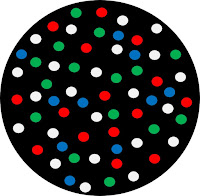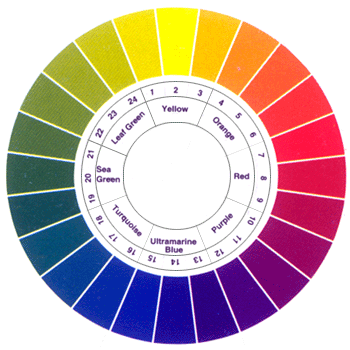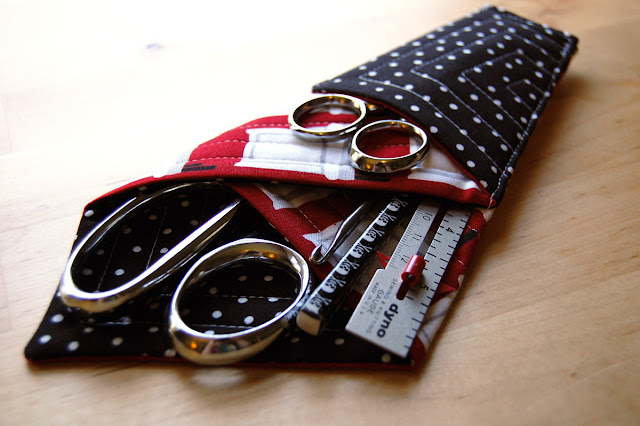The Visual Contrast Color Wheel is based on the theory of cone opponency in human color perception. So, I'm sure you might be asking yourself what exactly this is, along with, "Why is this wheel different than the red/yellow/blue color wheel?" or "What does Visual Contrast mean?" Read on below to find the answer to all of these questions!
Cone opponent theory applies to part of the human color perception process. Scientists think the cone opponent process explains optical illusions like colors that appear to shift when surrounded by other strong colors (simultaneous contrast).
First, let's review the trichromatic theory of human vision to find out how the cone opponent theory is related.
You might remember this basic science lesson about how we see colors with three different types of light-detecting cells in our eyes. There are two major types of light-detecting cells at the back of our eyes, one type called rods that detect only light or dark, and one type called cones that are tuned to detect different wavelengths of light.
The cone cells come in three flavors; LONG wavelength detectors, MEDIUM wavelength detectors, and SHORT wavelength detectors.
When these light-detecting cells are excited by light they send a strong signal through special nerve cells to the brain. Our brain processes this information, and we understand it as color. The longest wavelengths of light appear red, medium wavelengths appear green, and the shortest wavelengths appear blue.
Imagine the rods and cones covering the inside of the eye as little dots (this is a very simplified explanation). In this diagram the rods (cells that only respond to light/dark) are represented by white dots. Long-wavelength detecting cones are represented by red dots, medium-wavelength detecting cones by green, and short-wavelength detecting cones by blue. These little light-detecting cells connect to the brain through the optic nerve, sending a signal to the brain when stimulated.

Now imagine that these little light-detecting cells covering the back of the retina are grouped together in little bundles, connected with special nerve cells called
ganglion cells. One group of cones connected together with ganglion cells acts as one circuit and sends one signal to the brain for the whole group. This bundle is wired as a kind of detecting unit with a group of cones forming a center ring and a group of cones forming an outer ring. The circuit as a whole can send two optional signals, one signal if the outer ring is stimulated, and one signal if the inner ring is stimulated (illustrated above).
Imagine, whichever section of the bundle has more cones triggering in that group overall will determine which signal the bundle will send. And if you haven't guessed yet, these little bundles of cones connected with ganglion cells are the cone opponent channels.
There are different types of cone opponent channels in the retina detecting three major categories of information.
One cone opponent channel can signal either RED or GREEN to the brain. These RED/GREEN cone opponent channels can be wired in either of the two ways you see above (green in the center group/red in the outer group or red in the center group/green in the outer group). These channels will determine if more red or green light is being detected by the bundle of cones, and send that message to the brain.
Another cone opponent channel can signal either BLUE or YELLOW to the brain. These BLUE/YELLOW cone opponent channels can be wired in either of the two ways you see above (yellow in the center group/blue in the outer group or blue in the center group/yellow in the outer group). These channels will determine if more red or green light is being detected by the bundle of cones, and send that message to the brain.

The final type of cone opponent channel can signal either LIGHT or DARK to the brain. These LIGHT/DARK cone opponent channels can be wired in either of the two ways you see above (light in the center group/dark in the outer group or dark in the center group/light in the outer group). The LIGHT/DARK cone opponent channels may also be responsible for sending other information to the brain, like where sharp edges form. We won't worry about these channels as they don't signal color information.
If you display the red/green and blue/yellow opponent channel colors opposite each other you get a pretty good-looking color wheel.
In fact, this wheel is exactly the color wheel
Ewald Hering put forth in the 1870s when he first proposed cone opponency in human color vision.
This color arrangement is also the basis for
Wilhelm Ostwald's color system above, created in the early 1900's as a simple system for cataloging and matching colors.
And yeah, it's where the Visual Contrast Color Wheel comes from too! This isn't by any stretch of the imagination a NEW system, or even a NEW color wheel, it's just a system I believe works much better for exploring color relationships than any 3-pigment primary system (aka the red/yellow/blue or magenta red/yellow/cyan blue wheel).
Why does this color wheel do a better job of representing color relationships? Because it represents the opponent channel process in human color vision.
or even make two different colors look the same simply by placing colors next to other colors,
and you're already deeply familiar with simultaneous contrast. These kinds of color phenomena (along with the fun illusion of afterimages) are partially tied to the cone opponent process. It's been demonstrated by scientists that we see the same afterimage colors (seeing red after looking at green, seeing green after looking at red, etc.), and these pairs are represented in the Visual Contrast Color Wheel.

If you have a Visual Contrast wheel next to an RYB Artist's 3-pigment primary color wheel, you'll notice that there are colors like magenta and cyan in the Visual Contrast wheel that are missing in the RYB wheel. Since there are a few more colors in the Visual Contrast wheel, color pairs and harmonies will look different with these two wheels. And, because colors in the Visual Contrast wheel are closer to the pairs of colors our brains create for us in the illusions of successive and simultaneous contrast, and color combinations you discover with this color wheel are going to be vibrant and fresh, following the natural laws of human color perception.
I'd like to close out this post with a little disclaimer about color wheels. A color wheel is simply a diagram representing a specific color system, and the law of color systems is the application dictates the system.
When the application happens to be exploring your own sense of color or creating your own colorful designs or artwork, YOU get to choose the system. Even if the system you use is simply your own, inherent color esthetic! So don't get the idea that I'm saying you MUST use the Visual Contrast wheel, or that other color wheels shouldn't be used for color inspiration. I'm just saying that I prefer the Visual Contrast wheel as a representation of human color vision, and am sharing a little back-story for you as to why I came to that decision.

My philosophy is that anyone who creates with color (artist, crafter, florist, custom sign painter, fashion designer, house painter, mosaicist, illustrator, mangaka, etc.) can benefit from exploring color relationships. I teach classes and workshops that give people who work with color creatively a deeper understanding of how the limitations of human color perception can affect their work, and offer tools to help explore a deeper connection with personal color palettes. If you are interested in learning about color from me, check out my "Classes & Workshops" tab at the top of the blog. The page will be updated whenever a new event is added.



















Comments